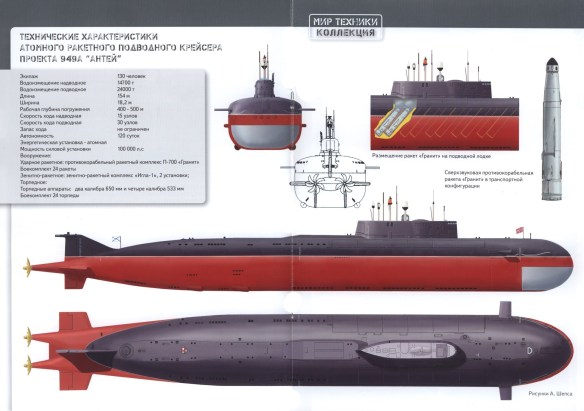The first third-generation nuclear “attack” submarine was Project 949 (NATO Oscar), the ultimate cruise missile submarine and-after Project 941/ Typhoon-the world’s largest undersea craft. 47 Development of the P-700 Granit anti-ship missile system (NATO SS-N-19 Shipwreck) was begun in 1967 to replace the P-6 missile (NATO SS-N-3 Shaddock) as a long-range, anti-carrier weapon. The Granit would be a much larger, faster, more-capable weapon, and it would have the invaluable characteristic of submerged launch. The missile would be targeted against Western aircraft carriers detected by satellites.
A short time later design was initiated of an associated cruise missile submarine at the Rubin bureau under Pavel P. Pustintsev, who had designed earlier SSG/SSGNs. 48 The possibility of placing the Granit on Project 675/Echo II SSGNs also was considered, but the size and capabilities of the missile required a new submarine.
The Granit would be underwater launched and have a greater range than the previous P-6/SS-N-3 Shaddock or P-70/SS-N-7Amethyst missiles. Being supersonic, the missile would not require mid-course guidance upgrades, as did the earlier Shaddock. The decision to arm the Project 949/Oscar SSGN with 24 missiles-three times as many as the Echo II or Charlie-meant that the new submarine would be very large. The missiles were placed in angled launch canisters between the pressure hull and outer hull, 12 per side. As a consequence, the submarine would have a broad beam-giving rise to the nickname baton (loaf). The 592/3-foot (18.2-m) beam would require a length of 4721/3 feet (144 m), providing for nine compartments. Although the submarine was not as long as U. S. Trident SSBNs, the Oscar’s greater beam meant that the submarine would have a submerged displacement of 22,500 tons, some 20 percent larger than the U. S. Trident SSBNs.
Beyond 24 large anti-ship missiles, the Oscar SSGN has four 533-mm and four 650-mm torpedo tubes capable of launching a variety of torpedoes and tube-launched missiles. 49 The submarine has the MGK-500 low-frequency sonar (NATO Shark Gill), as fitted in the Typhoon SSBN, and the MG- 519 (NATO Mouse Roar) sonar.
The large size of the Oscar and the need for a speed in excess of 30 knots to counter U. S. aircraft carriers required a propulsion plant based on two OK-650b reactors powering turbines and twin screws. The twin-reactor plant produces 100,000 horsepower, according to published reports. This plant and the similar Typhoon SSBN plant are the most powerful ever installed in submarines.
The keel for the lead ship of this design was laid down on 25 June 1978 at the Severodvinsk shipyard. The submarine was commissioned on 30 December 1980 as the Minskiy Komsomolets (K-525).50 Series production followed. Beginning with the third unit-Project 949A/Oscar II-the design was lengthened to 5081/3 feet (155 m). The additional space was primarily for acoustic quieting and the improved MGK-540 sonar, with a tenth compartment added to improve internal arrangements. These SSGNs-as well as other Soviet third generation submarines-are considered to be extremely quiet in comparison with previous Soviet undersea craft. The changes increased the surface displacement by some 1,300 tons.
The large size and cost of these submarines led to some debate within the Soviet Navy over the means of countering U. S. aircraft carriers. As many as 20 submarines of Project 949 were considered, although according to some sources, the cost of each was about one-half that of an aircraft carrier of the Admiral Kuznetsov class. Two naval officer-historians wrote: “It is obvious . . . the ideological development of the [SSGN], namely Project 949, overstepped the limits of sensible thought and logic.”
Project 949/Oscar SSGNs posed a major threat to U. S. aircraft carriers and other surface forces because of their missile armament and stealth. The massive investment in these submarines demonstrated the continuing Soviet concern for U. S. aircraft carriers as well as the willingness to make massive investments in submarine construction.
Through 1996 the Severodvinsk yard completed 12 Oscarclass SSGNs-two Project 949 and ten improved Project 949A submarines. The 11th Oscar II was launched in September 1999, apparently to clear the building hall, and is not expected to be completed. These submarines periodically undertook long-range operations, a concern to the U. S. Navy because their quieting made them difficult to detect and track. On 12 August 2000, as Soviet naval forces held exercises in the Barents Sea, reportedly in preparation for a deployment to the Mediterranean, the Kursk (K-141) of this class suffered two violent explosions. They tore open her bow and sent the submarine plunging to the sea floor. All 118 men on board died, with 23 in after compartments surviving for some hours and perhaps a day or two before they succumbed to cold, pressure, and rising water. The cause of the disaster was a Type 65-76 torpedo fuel (hydrogen-peroxide) explosion within the forward torpedo room, followed 2 minutes, 15 seconds later by the massive detonation of 2 torpedo warheads.
The Kursk, ripped apart by the two explosions, sank quickly. The four previous Soviet nuclear propelled submarines that had sunk at sea had also suffered casualties while submerged, but were able to reach the surface, where many members of their crews had been able to survive. They were able to do this, in part, because of their compartmentation and high reserve buoyancy; the explosions within the Kursk were too sudden and too catastrophic to enable the giant craft to reach the surface.
